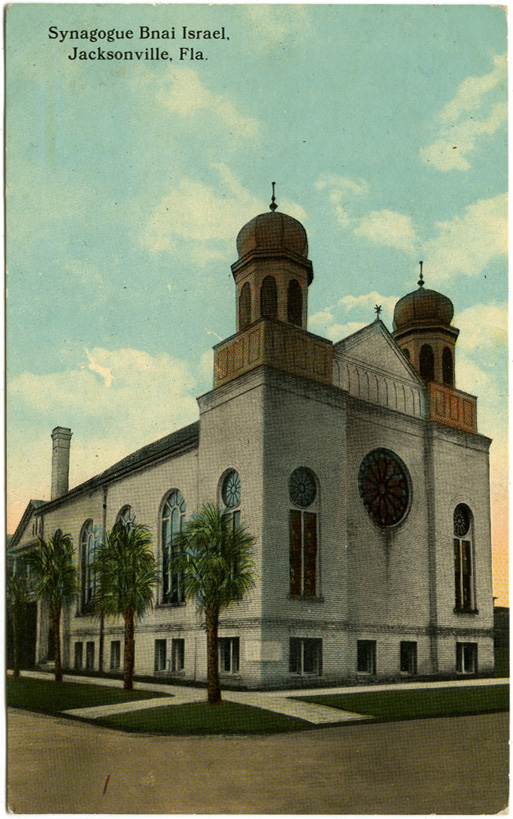5.10 Jacksonville, Florida
Congregation B’nai Israel, West Duval and North Jefferson streets
Architect unknown, 1909
H. and W. B. Drew Co., Jacksonville, Florida, publisher; no date
This postcard is one of the few illustrations of Jacksonville’s B’nai Israel (Sons of Israel) synagogue, erected by the city’s Orthodox congregation in the LaVilla neighborhood and opened in 1909. This was the culmination of community aspirations begun with the first settlement of Jews from Lithuania in the 1880s but precipitated in the mid-1890s when Jacksonville’s earlier congregation, Ahavath Chesed, adopted Reform Judaism, leaving the new immigrants without a religious home.
By 1901, the same year a devastating fire destroyed much of downtown Jacksonville, including the old synagogue, the Orthodox community incorporated as the Hebrew Orthodox Congregation B’nai Israel and began planning its own building. In 1905, a young Jewish ritual slaughterer named Benjamin Safer was recruited to Jacksonville from Lithuania to open a kosher market; he also served as religious leader of B’nai Israel until a rabbi was hired in 1919.
The majestic synagogue with its two tall towers is one of the most architecturally distinctive houses of worship in the South built by recently-established Eastern European immigrants. With its tall sanctuary space raised over a well-lit basement level, large arched windows, and especially the two towers surmounted with small domes, B’nai Israel somewhat recalled the form of many Reform temples of the previous decade, such as Temple Sinai in Lake Charles, Louisiana.
There were, however, fundamental differences that reflect distinctions between Reform and Orthodox religious practice. In Jacksonville, B’nai Israel’s entrance is not on axis between the towers, but because the towers flank the east wall, the entryway is on the building’s south facade. Inside, the holy ark (in Hebrew, aron ha-kodesh) was set beneath the oculus window. There are no known photos of the interior, but there was probably an interior gallery for women on two sides of the sanctuary. Significantly, in 1910, when rival congregation Ahavath Chesed opened its new synagogue at Laura and Ashley, it was built in the Reform Movement’s preferred classical style.

In the 1920s, B’nai Israel affiliated with the Conservative Movement and adopted the then-popular synagogue-center concept to best offer Jewish religious, educational, and social activities intended to strengthen local Jewish identity and community and encourage young people to engage in synagogue life. In 1927, the congregation bought land in the Springfield neighborhood and changed its name from B’nai Israel to the Jacksonville Jewish Center. The new building, erected at West 3rd and Silver Streets, was designed in a stripped-down classical style that owed much to the contemporary Art Deco taste. The congregation’s two-tower 1909 building was sold and used as a church until 1975, when it was demolished.
By the late 1950s, the Jewish Center had expanded to include a two-story sanctuary, chapel, school, library, gymnasium, meeting room, and office space. In the 1976, the Center again moved, this time to Mandarin on the St. Johns River in the south part of the city. The 1927 complex was sold and became the Jacksonville Job Corps Center. It was demolished in 2011.
